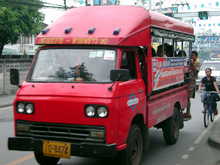- Nissan Caball
-
Nissan Caball is a light commercial truck manufactured by Nissan Motors from December 1957 until December 1981. The Caball was mainly sold in Japan, Hong Kong, South East Asian countries, Australia, New Zealand, and few European countries. While the Caball name came to an end in 1981, its replacement received the Nissan Atlas name in the domestic Japanese market (Cabstar in the export). These are 2-4 ton trucks, the lighter versions in the Atlas truck range took over after the lesser Cabstar/Homer.[1]
First generation (C40)
First appearing in December 1957, the Nissan Junior Caball began as a cab-over version of the B40-series Nissan Junior.[1] Like the Junior, the Junior Caball used the 1.5 L (1,489 cc) "1H" four-cylinder engine, developing 50 PS (37 kW) at 4,400 rpm. In August 1958 the C42 version was released, with power up to 57 PS (42 kW).[2]
Second generation (C140)
This was introduced in April 1960 and continued in production until replaced by the C240 series six years later.[1] While almost identical in appearance to the C40, it featured an all-new 1.5-litre G-series engine also seen in the Cedric. Power was up to 71 PS (52 kW) at 5,000 rpm. There was also a bus version called the Echo (GC140), which was introduced a month before the Caball.[3] This was the first Caball to see export markets outside of Asia, reaching a certain level of success in Australian and Central American markets. There were also VC140 (van) and KC140 (microbus) versions available.[4]
In 1962 the C141 Caball was introduced, which is when the "Junior" part of the name was dropped and the truck simply became the "Nissan Caball". While the 1.5-litre "G" engine remained available, the main engine was now the 1,883 cc H engine, offering 85 PS (63 kW). In 1963 the Caball underwent a major change, with the front sheetmetal replaced and with a more bulging, "droopy-eyed" appearance.[5] There was also a QC141 version available, featuring a 2,164 cc SD22 diesel engine producing 70 PS (51 kW). In late 1965, the two petrol engines were replaced by the 1,982 cc H20 engine, with 99 hp (74 kW). This (now the C143) was the last Nissan vehicle where the doors were hinged at the rear.[6]
Third generation (C240)
The second generation Caball first appeared in August 1966.[1] Also renewed at the same time was the bus version "Echo", which received the GC240 chassis code.[3]
Fourth generation (C340)
The third and last generation Caball was introduced in May 1976. This generation was also marketed as the Nissan Clipper, a nameplate acquired with Nissan's takeover of the Prince Motor Company.[1] The C340 used the cab and chassis of the preceding C240, but received a different front treatment and was somewhat longer.
References
- ^ a b c d e "Nissan Fact File 2004-2005". Nissan. 2005. pp. 24–27. http://www.nissan-global.com/EN/DOCUMENT/PDF/FF/2004/NissanFF_E_24-27.pdf.
- ^ Ozeki, Kazuo (2007) (in Japanese).
日本のトラック・バス 1918~1972 [Japanese Trucks and Buses 1918-1972]. Tokyo: Miki Press. p. 103. ISBN 978-4-89522-494-9. - ^ a b "Company Development, Heritage: 1960's". Nissan. http://www.nissan-global.com/EN/COMPANY/PROFILE/HERITAGE/1960/. Retrieved 2011-06-09.
- ^ Bent, Alan. "1960 Nissan Junior Caball C140". Earlydatsun.com. http://www.earlydatsun.com/nissanc140.html. Retrieved 2011-06-10.
- ^ Bent, Alan. "1962 Nissan Junior Caball C141". Earlydatsun.com. http://www.earlydatsun.com/nissanc141.html. Retrieved 2011-06-10.
- ^ Bent, Alan. "1965 Nissan Caball C142". Earlydatsun.com. http://www.earlydatsun.com/nissanc142.html. Retrieved 2011-06-10.
See also
- Nissan Junior
- Prince Clipper
- Nissan Atlas
Categories:- Nissan vehicles
- Trucks
Wikimedia Foundation. 2010.

